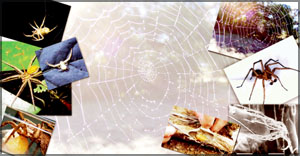|
observer |
|
|
|
|
|
OTHER LINKS |

|

|

|
|
Spiders: Part II Fascinating FactsWell, last week, we enlightened you briefly about some fascinating creepy crawlies, the spiders. Perhaps, you took some time to observe how spiders that you may have come across in your home or garden behave?
As we explained before, the world of spiders is a very fascinating one because there are so many different species. Today too, we will journey into this world to learn more about these creepy crawlies that frighten most people. Remember, even little Miss Muffet in the popular nursery rhyme was not allowed to eat her curd and whey in peace without one of those creatures frightening her... As you may know by now, spiders are not classified as insects, but as arachnids. So, let's check out what their differences are. Both insects and arachnids are widespread and found in abundance throughout the world because they belong to the largest group of animals, the arthropods. (animals with hard external skeletons and jointed limbs). In Greek, arthro means joint and podos means footed. Scorpions, millipedes and centipedes also belong to this group. Even though spiders are related to insects, there are many differences that have resulted in these creatures being classified as a separate order. For instance spiders have two main body parts, eight legs, piercing jaws, simple eyes and silk spinning organs called spinnerets on their abdomen. Insects on the other hand have three main body parts, six walking legs, compound eyes, antennae and chewing jaws (mandibles). Most insects can fly but spiders cannot do so. Now that you know the basic differences, let's check out some more interesting facts about them. First, we'll examine how they grow. A spider's life cycle can be divided into three stages - the embryonic stage, larval stage and nympho-imaginal stage. The time between the egg being fertilised and the spider begins to take shape is known as the embryonic stage. Then it begins to look more and more like a spider. It enters the second stage as a prelava and through subsequent moults, and reaches the larval form. It feeds off its yolk supplies to grow. If you are wondering what moulting is, let us enlighten you. A spider grows by periodically shedding its semi-rigid external 'skin' or cuticle of semi-rigid chitin. It's replaced with new, larger ones grown underneath the old one. This process is called moulting or ecdysis. In stage three, the spider which has gone through many moults, and its organ systems are all complete, is ready to start hunting. The third stage is sub-divided into two stages - the nymph or juvenile stage and the image or adult stage. Did you know that spiders have an open circulatory system? They do not have real blood or veins to convey the blood. They are filled with haemolymph which is pumped through the arteries by a heart into spaces known as sinuses surrounding internal organs. They also have many eyes ranging from 8, 6, to 2 though most often one pair is well developed than the others. Some species, especially those that live in caves, have no eyes! As we explained in the previous article, most spiders find their way about and hunt prey by touch not by sight. Hunting spiders such as wolf and jumping spiders have fairly excellent eyesight, while the latter species can even see in colour from their well developed pairs of eyes. What silk is used for The silk produced by spiders have many uses for them... It is used not only to capture prey, but also to aid in climbing, form smooth walls for burrows, build egg sacs, and wrap prey among many other things. Spider classification Presently over 40,000 different species of spiders have been identified and they have been put into about 111 families. It is believed that upto 200,000 species may exist. The order of arachnids to which the spiders belong has been composed of three sub orders. What are garden spiders and water spiders? Garden spiders are harmless to people. They eat flies and other insects. These spiders usually spin orb webs. Water spider look huge due to their long legs. They live in ponds, underwater. It is the only spider that can swim freely underwater. Water spiders swim upside down. It usually traps a bubble of air and brings it below to its home to breathe while underwater. These spiders eat bugs. But, don't look for them in the ponds in your home gardens because they are only found in Europe. Smallest and the largest The smallest spiders are anapid spiders, sometimes called armoured because of the cuticular plates on their pin-head size bodies. They are usually found in damp, cool habitats such as among forest leaf litter and moss, The largest species include the South American Goliath Tarantula which has legs that can span a dinner plate! Spiders that don't spin webs Brazilian wondering spider Brown recluse Huntsman Nursery web spider Spitting spiders Wolf spiders Trap-door spiders Tarantulas Spiders linked to fatalities in humans or other health Brazilian wandering spider Australian funnel web spider Widow spiders Recluse spiders. concluded |











